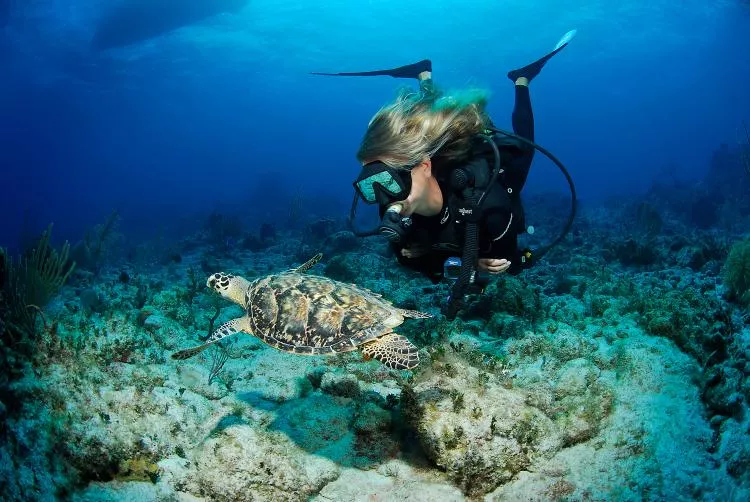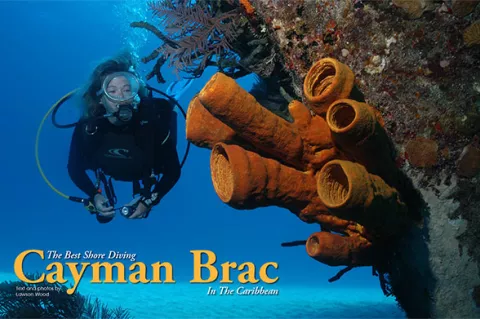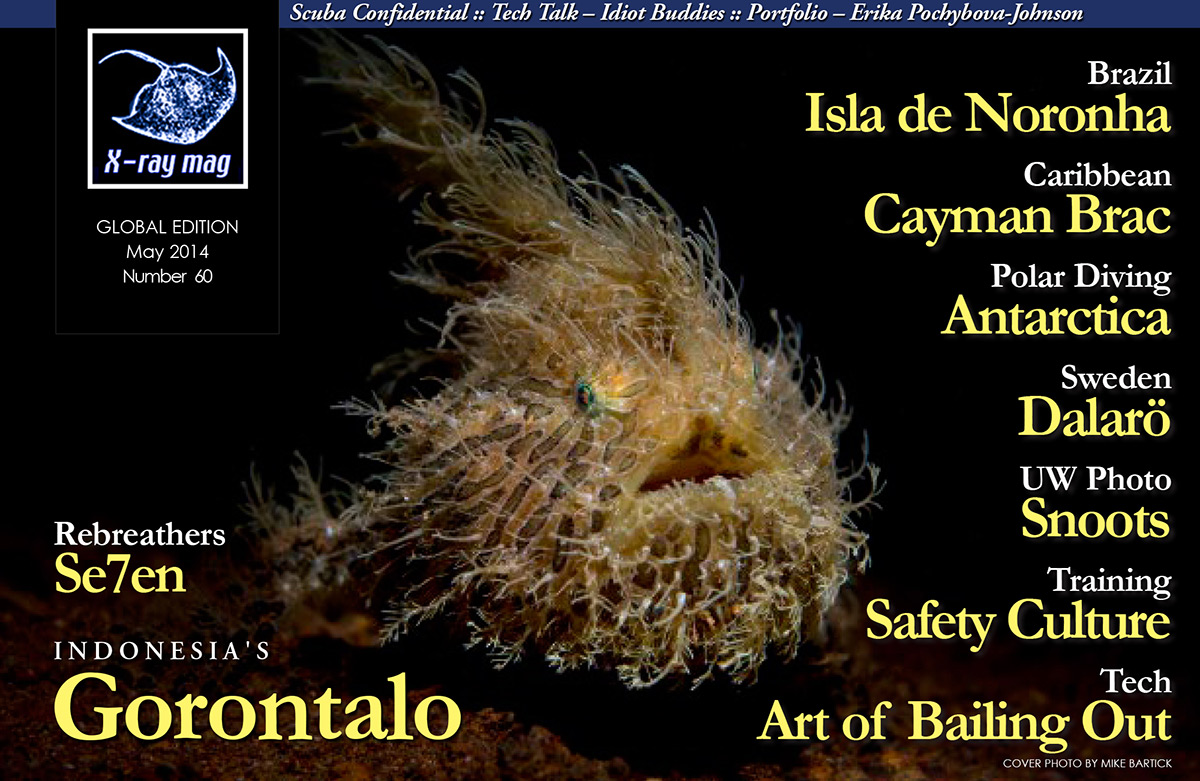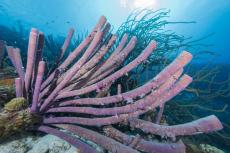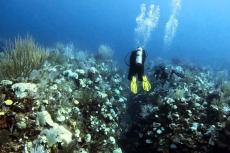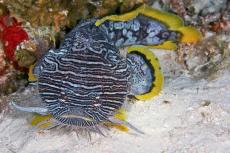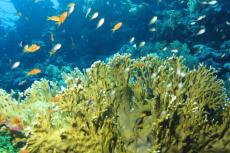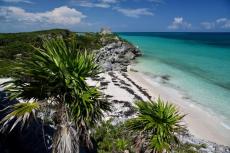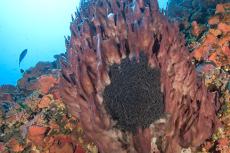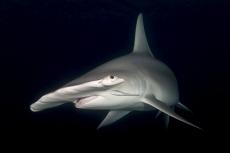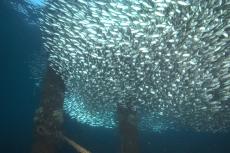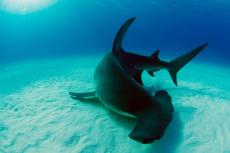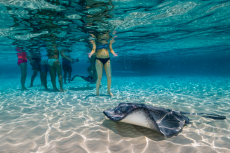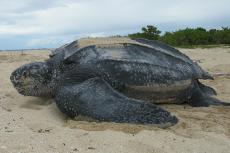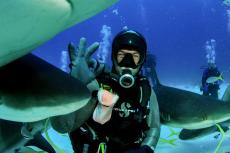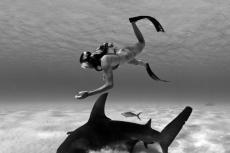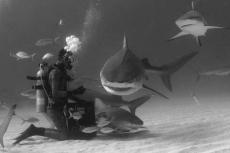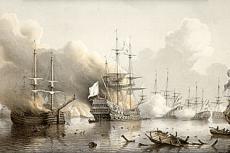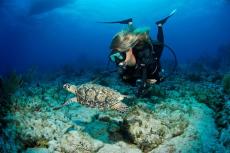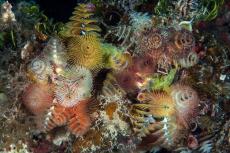First visited by Christopher Columbus in 1503, his reports tell of incredible numbers of fish, turtles and crocodiles hence their original name of Caimen or The Cayman Islands.
Contributed by
Whether entering these waters as a novice or as a more experienced diver, what is obvious is that Cayman waters have some of the clearest waters in the Caribbean, with very few currents they are the ideal destination for virtually guaranteed results. The group of islands sit atop three huge submarine mountains and have incredibly deep water all around, resulting in any sedimentation or particulate in the water to sink into the depths, keeping the coastal waters nice and clear all year round.
Cayman Brac, Grand Cayman’s farthest sister island is known affectionately as “the island that time forgot” and at only 20 km long (12 miles) by just over 1.6 km wide (1 mile) and with a resident population of only around 1500 people you can easily see why. There are only two hotels on the island: The Brac Reef Beach Resort and the Alexander. The Brac Reef is home to the famous Reef Divers dive business, but there is a new dive centre, The Brac Scuba Shack run by the very experienced Martin & Liesel van der Touw that is now catering to the larger number of shore divers who are coming to stay on the island. Offering private boat charter and twin tank boat dives, they are perfectly suited for hiring and collecting your dive tanks for all the shore dives available, if you want to cater for yourself without the limits of time.
The Brac is roughly split into two, with the flat area to the west of the island where the airport and dive shops are located and the steep bluff with its remarkable ancient coral limestone cliff and caves at North East Point which rises to 42 metres (140 feet). The word “Brac” is Gaelic for “Bluff”. The locals are known as Brackers and the island is the smallest in the Caribbean to host a full jet service.
With direct jet flights from Miami into the Charles Kirkconnel International Airport and a large number of small B&B and rental apartments as well as the two resort hotels, Cayman Brac has rapidly earned its reputation as the top shore diving island in the entire Caribbean. (Bonaire used to hold this accolade, but a number of the sites are often off limits and several are quite difficult to undertake).
North shore
The beauty of Cayman Brac is that virtually the entire north shore has small ‘barcaderes’—or boat slips dating back several hundred years, where the famous Cat Boats were built and launched. These small slipways are perfect for easy access onto the shallow fringing and barrier reefs, plus, of course, the larger concrete slipways and stepped entries for more modern craft. Toilets and picnic tables can be found at a number of the shore sites, making things that bit more comfortable and with an almost total lack of diver pollution, the shore diving to be found off Cayman Brac is second to none. Weather dependent, the south shore also has a number of boat ramps and slipways as well as direct access to all of the inshore reefs and the main sheltered lagoon at the west end.
The isolation of the Island has served it well. The corals are in good condition and there is a vast variety of marine life recorded in the registered 49 dive locations with mooring buoys, including seven wrecks. Now a new local initiative has placed markers at many new shore diving locations. Marked with a small red stone and a number, these sites are dotted all around the island and certainly expand the variety of dives on offer to around 100 accessible dives, each with their own particular attributes and are not necessarily the same as any other along on the same bay ...
South side
The southern sites on Cayman Brac also resemble those on Grand Cayman, with a classic spur and groove reef system, but here it is more pronounced and the wall starts around 20 metres (66ft). The wall is more gently sloping in this area and starts much further out from the shore. This means that there are large areas of sand flats with small but very good quality coral growths on the lower slopes. Lots of elk horn coral as well as numerous large sponges. However the area tends to be ignored as many visiting divers opt for the boat dive option of crossing the short distance to Little Cayman Island, this results in the reefs being relatively under dived.
Fry Cove. One of the best dives is Fry Cave, located off Salt Water Point. Weather dependent and with a moderate swell, the cave is on the same type of rugged spur and groove reef and mini wall cut by many different gullies and canyons. Lots of elk horn and pillar corals in good structure and form make this a delightful dive. Snapper and sergeant majors make a nuisance of themselves. The fry of Fry Cave name are Silverside minnows comprising of four different species of juvenile fish which congregate together to make one huge mass of moving fish, found in the summer months. This is a very interesting area for invertebrates including file clams, nudibranchs, arrow crabs and good quality sponges and sea fans. Pistol shrimp can be found amongst the coral rubble as well as jawfish and yellow sting rays. This is similar to the reef off Public Beach where there is a three tier reef structure starting in the shallows and ranging down to over 30m (100ft).
Prince Frederick wreck. When the sea is calm, the wreck of the Prince Frederick which sunk in 1888 can be accessed from the shore. It is situated about half way down the south shore and is easily identified as it is directly out from a curiously shaped building known as the ‘Bubble House’ and offers a shallow dive with easy sight of the remnants of the ship quite visible as there are a handful of superb Trotman anchors, a steel mast, anchor winch, ‘ribs, hooks and knees’—are all identifiable with good coral growth and many varieties of fish. The entire south shore coastline is accessible with some entries being made off the ironshore edge and others with easy access over a sandy beach. The coast further to the east has more difficult entry, but the results are superb as these sites are rarely, if ever, dived.
Captain Keith Tibbetts and Topsy wreck. The majority of all dives are undertaken along the north shore of Cayman Brac. Virtually all of the wreck sites are here, as well as some absolutely cracking reef dives, both down the wall and in the shallows for your second dive each morning. Along the northwest shore can be found the wreck of the Russian Frigate #356, renamed the Captain Keith Tibbetts after one of the islands notable men, is a must to dive. It is the largest shipwreck on all three islands that can be reached from the shore. Now referred to simply as the “356” this shipwreck is superb for all levels of diver.
The shore entry for this dive is from the sea pool at Buccaneer with very easy entry and exit. This shoreline is perfect for snorkelers, too, as they will come across the wreckage from the Topsy in only a metre (3ft) of water. The Topsy’s anchor is used as a mooring for the day dive boats but is also handy as a visual aid for diving the site at night.
Charlie’s Reef. Charlie’s Reef is another shore dive that can easily be accessed, leaving your vehicle on the concrete dock; you are able to enter the water either by a fool hardy leap, or a more sedate entry from the stainless steel steps. The wall here starts fairly close to shore and whilst many people are quite content to spend their time amongst the excellent spur and groove reef formations, most quite often opt for the longer swim out to the wall and a better chance to see large jacks, eagle rays and sharks.
Kissimmee wreck. Nearby is the Kissimmee wreck, located just northwest of Scott’s Pier, nearby the airport; it sits in 12m (40ft) of water and is almost upside down. This retired tug boat was deliberately sunk in 1982 as an addition to the reef system and provides an interesting start to a shore dive that can take you out to the edge of the reef wall, as this is the closest point on the island to undertake this type of dive.
The wreck is a favourite site for photographers, and during the summer months, large numbers of rays can be seen. This location is also superb for night dives as there is easy access and the rock pier has overhead lights, which makes things easier for navigation. Here, we always find octopus, squid, juvenile spotted drum fish and many species of shrimp.
Barbara Ann wreck. The wreckage of the Barbara Ann, a former landing craft, is well spread out in the shallows, but it is superb as it has become its own little eco-system and is stuffed full of incredibly colourful sponges, sea fans, and tons of invertebrates and small fish species such as pufferfish, wrasse and various blennies and gobies. This is one of the few sites where you can always find juvenile queen anglefish and painted lady cleaning shrimps.
Stake Bay. Further east along the coast at Stake Bay are more superb shore diving sites. Stake Bay is where the island’s government administration buildings and museum are located, and there is a huge ramp and stepped slipway to make access nice and easy. This region of the north coast is quite protected, and there are some simply massive barrel sponges and ginormous seafans and soft corals. This site also has two sculpture structures, the first is of dolphins and rays, and the second is a local artist known as Foots and his rendition of his idea of Atlantis. There are statues, columns a huge sun dial and other artefacts. These are now all covered in sponge growth and make for an interesting photographic backdrop.
Cayman Brac Dock. The Cayman Brac Dock is off limits whilst it is open, but as you can imagine, when it is closed, it is accessible from either side and large schools of big barracuda can be found hanging out in the shade. The construction spoil is well overgrown, and you can always find a huge variety of tropical fish and invertebrates.
Burt Brothers. One of the best of the shore dives along the northeast is Burt Brothers, located opposite a small shop called NiM Things (Native Island Made). A concrete boat ramp is great for access, and from here, it is just a short swim to some massive coral structures edged with deep-water gorgonians and their usual spider crabs. Hammerhead sharks are seen here in January and February, but really it is the colourful and very good corals that make this dive special.
Bluff. Under the ancient Bluff is always the feather in a diver’s cap, as it is very rare that the sea conditions are so perfect to allow this diving in an otherwise pristine diving location. Scoured by storms, there are very few robust seafans or sponges as everything is low lying.
However, there are kazillions of featherduster worms, small nudibranchs, blennies and gobies and an otherwise undived terrain of huge boulders, with interesting swimthroughs, various shipwrecks’ parts and simply staggering visibility, as there are no sandy areas to get kicked up by rough waters.
Benefits of Brac
Great emphasis has always been placed on the diving on Grand Cayman and the North Wall is outstanding, plus everyone raves about Bloody Bay Wall on Little Cayman Island, but many fail to appreciate the facts that Cayman Brac has much smaller diver numbers; more shore diving sites making for unlimited shore and night diving; four major wreck sites as shore dives and diving conditions and reefs that more than match all the other islands in the Caribbean.
With the island being only 20km long (12mi) long, everything is so close by that it makes the shore diving and snorkelling that much easier. There is, in fact, very little else to do on the island, other than exploring the historic caves and caverns; visiting the museum; birding; rock climbing; snorkelling; kayaking; windsurfing; fishing or generally laying back and enjoying the superb beaches along the south shore; rockpooling or having fun getting drenched at the blowholes.
Each of the major families has a provisions store of some sort and all will sell homemade jams and chutneys (in season) as well as the usual goods. I would recommend that you buy the local (very rare)
Caymanite Rock jewellery; the island craftsmen are excellent. The local residents are some of the friendliest I have come across.
If you are not diving, then you are thinking about it, or getting your cameras ready, or travelling to or from a dive site. Cayman Brac diving is similar to Grand Cayman, without the numbers of divers, and for that reason, it has become a great favourite with the world’s diving fraternity—particularly those who prefer to dive away from the madding crowd.
Best time to go
With air temperatures averaging 30-40oC (80-90oF) in the summer, it can be hot and humid, and as always in the Caribbean, hurricane season is from June to November each year. However, some of the best diving is also done in these same months as the sea is generally at its most calm, there are less tourists and better opportunities for marine life encounters. You can dive all year round, as the island has plenty of great dive sites that are always available depending on wind and weather.
One point to make here is that the underwater visibility is very rarely less that 30m (100ft). The temperature ranges from around 22°C (72°F) in December to 29°C (84°F) in July.
Where to stay
All of the accommodation is similarly priced and styled. Apart from the individual self catering apartments and villas, the hotels have good restaurants attached, particularly the Brac Reef Hotel, which is superb.
Meals are generally buffet style and there is plenty of it, more than enough for the active diver. Lunches tend to be a local spicy dish of fish or chicken, soup, salad and a sweet of some kind as well as fruit and soft drinks.
Many visiting divers keep the last afternoon free to off-gas and explore the caves and caverns and obviously the local gift shops for a piece of Caymanite jewellery, or perhaps go exploring along the shore to perhaps find your own piece of Caymanite rock or up on the outer Bluff edge to catch those spectacular sunsets.
Brac Scuba Shack is a great dive shop with excellent, qualified staff and catering for those who prefer shore diving or private charter. They also offer advice on all types of accommodation.
Brac Reef Beach Resort is a newly refurbished hotel with comfortable rooms, complete wifi throughout the complex, with a swimming pool, a raised deck area and a great bar right on the beach. Its own dive centre is situated next to the jetty. Reef Divers has a well-stocked shop, and the local photo pro, Ed Beaty, is on hand to guide you through the many and varied steps of digital underwater photography and videography. Barbecues are common on the grounds and at night downwards facing flood lights attract tarpon, squid and stingrays into the shallows, a perfect end to the day’s diving.
The Alexander Hotel is located near the beach at the west end of the island. Rooms are modern with wifi access, and the bar looks to the east over a large brackish pond popular with wild fowl. ■

